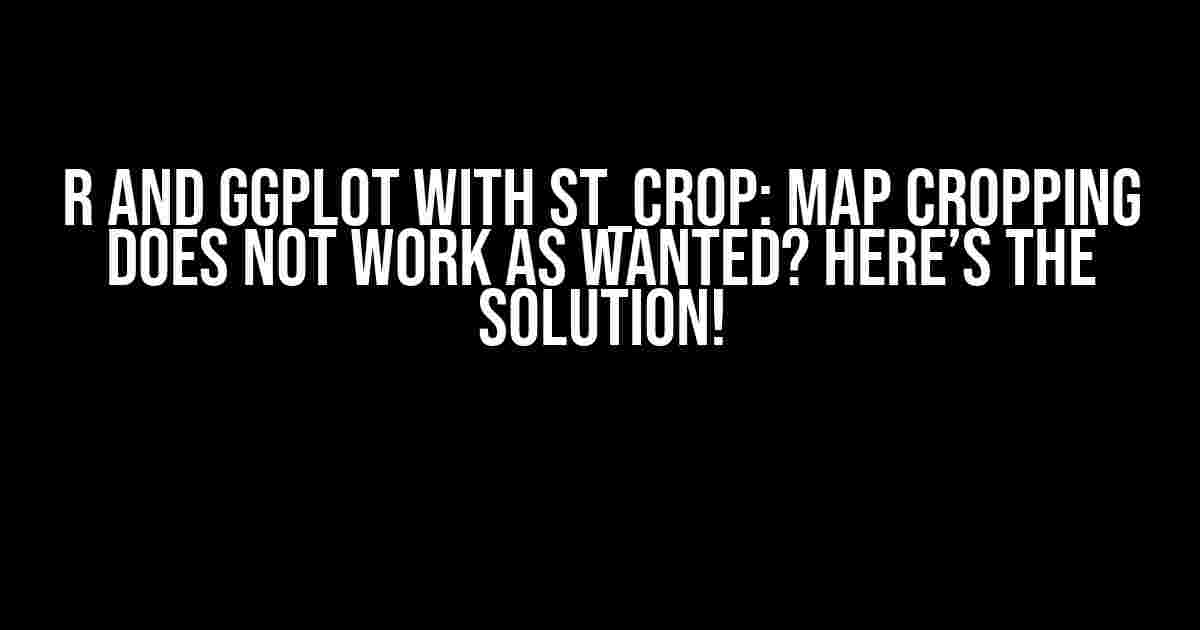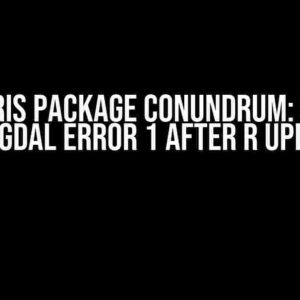Are you tired of struggling with map cropping using R, ggplot, and st_crop? You’re not alone! Many R enthusiasts have encountered this frustrating issue, but fear not, dear reader, for we have a comprehensive guide to help you overcome this hurdle.
The Problem: Map Cropping Not Working as Expected
When working with spatial data in R, you might want to crop your map to focus on a specific region or area of interest. This is where st_crop comes in – a powerful function from the sf package that allows you to crop spatial data to a specific bounding box or polygon. However, if you’ve tried using st_crop with ggplot, you might have noticed that the map cropping doesn’t work as expected.
# Load necessary libraries
library(ggplot2)
library(sf)
# Create a sample spatial data frame
df <- data.frame lon = c(-95, -90, -85), lat = c(30, 35, 40))
df_sf <- st_as_sf(df, coords = c("lon", "lat"), crs = 4326)
# Try to crop the map using st_crop
df_sf_cropped <- st_crop(df_sf, x = c(-92, -88), y = c(32, 38))
# Plot the cropped map using ggplot
ggplot() +
geom_sf(data = df_sf_cropped) +
theme_void()
The Issue: Why Map Cropping Fails
The reason why map cropping doesn't work as expected is because ggplot doesn't understand the sf object returned by st_crop. By default, ggplot treats the sf object as a regular data frame, ignoring its spatial properties. This leads to a map that's not cropped as intended.
The Solution: Convert sf Object to a ggplot-compatible Format
To overcome this issue, we need to convert the sf object returned by st_crop into a format that ggplot can understand. One way to do this is by using the as.data.frame() function to extract the coordinates and then reconstructing the spatial data using the ggplot2::coord_sf() function.
# Load necessary libraries
library(ggplot2)
library(sf)
# Create a sample spatial data frame
df <- data.frame(lon = c(-95, -90, -85), lat = c(30, 35, 40))
df_sf <- st_as_sf(df, coords = c("lon", "lat"), crs = 4326)
# Crop the map using st_crop
df_sf_cropped <- st_crop(df_sf, x = c(-92, -88), y = c(32, 38))
# Convert sf object to a ggplot-compatible format
df_cropped <- as.data.frame(df_sf_cropped)
df_cropped$geometry <- NULL
df_cropped <- df_cropped %>%
mutate(X = st_coordinates(.)[, 1], Y = st_coordinates(.)[, 2])
# Plot the cropped map using ggplot
ggplot(data = df_cropped) +
geom_point(aes(x = X, y = Y)) +
coord_sf(xlim = c(-92, -88), ylim = c(32, 38), expand = FALSE) +
theme_void()
Explanation: How the Solution Works
In the solution above, we first crop the map using st_crop, which returns an sf object. We then convert this sf object to a regular data frame using as.data.frame(). Next, we remove the geometry column and extract the coordinates using st_coordinates(). Finally, we reconstruct the spatial data using ggplot2::coord_sf() and plot the cropped map using geom_point().
Additional Tips and Tricks
- Use coord_sf() with caution: When using coord_sf(), make sure to set the x and y limits explicitly to avoid any unexpected map distortions.
- Verify your CRS: Ensure that your spatial data has the correct Coordinate Reference System (CRS) specified. This can affect the accuracy of your map cropping.
- Experiment with different geom functions: Depending on your spatial data, you might want to try using different geom functions, such as geom_sf() or geom_point(), to achieve the desired visualization.
Common Pitfalls to Avoid
- Forgetting to set the CRS: Failing to specify the correct CRS can lead to incorrect map cropping and projections.
- Not converting sf object to a ggplot-compatible format: Neglecting to convert the sf object to a format that ggplot can understand will result in an incorrectly cropped map.
- Using the wrong geom function: Using an incompatible geom function can lead to an incorrect visualization of your spatial data.
| Function | Description |
|---|---|
| st_crop() | Crop spatial data to a specific bounding box or polygon. |
| as.data.frame() | Convert an sf object to a regular data frame. |
| ggplot2::coord_sf() | Reconstruct spatial data for use with ggplot. |
Conclusion: Mastering Map Cropping with R, ggplot, and st_crop
By following the steps outlined in this article, you should now be able to successfully crop your maps using R, ggplot, and st_crop. Remember to convert your sf object to a ggplot-compatible format, use the correct geom function, and set the CRS and x and y limits explicitly. With practice and patience, you'll become a master of map cropping in no time!
Frequently Asked Question
R and ggplot are powerful tools for data visualization, but sometimes we encounter issues like map cropping not working as wanted with st_crop. Let's dive into the most frequently asked questions and answers about this topic!
Q1: Why does st_crop not work as expected when cropping a map in R?
A1: This could be due to the coordinate reference system (CRS) of your spatial object not being correctly set. Make sure to set the CRS using the `st_crs()` function before cropping the map. Also, ensure that the cropping boundaries are within the extent of the original map.
Q2: How can I specify the cropping boundaries accurately using st_crop?
A2: You can specify the cropping boundaries by providing a bounding box in the form of a vector of length 4, containing the minimum and maximum x and y coordinates (i.e., xmin, xmax, ymin, ymax). For example, `st_crop(your_map, bbox = c(xmin, xmax, ymin, ymax))`.
Q3: What if I want to crop the map to a specific country or region?
A3: You can use the `st_join()` function to merge your spatial object with a boundary dataset (e.g., country borders) and then crop the map using `st_crop()`. Alternatively, you can use the `st_intersection()` function to intersect your spatial object with the boundary dataset and get the desired cropped map.
Q4: How do I visualize the cropped map using ggplot?
A4: You can use the `ggplot()` function from the ggplot2 package to visualize the cropped map. Simply pass the cropped spatial object to `ggplot()` and use the `geom_sf()` function to render the map. For example, `ggplot(cropped_map) + geom_sf()`.
Q5: What are some common issues to watch out for when using st_crop with ggplot?
A5: Some common issues to watch out for include incorrect CRS, mismatched coordinate systems, and forgotten `st_crs()` function calls. Also, make sure to check the extent of the original map and the cropping boundaries to avoid cropping outside the map's boundaries.


